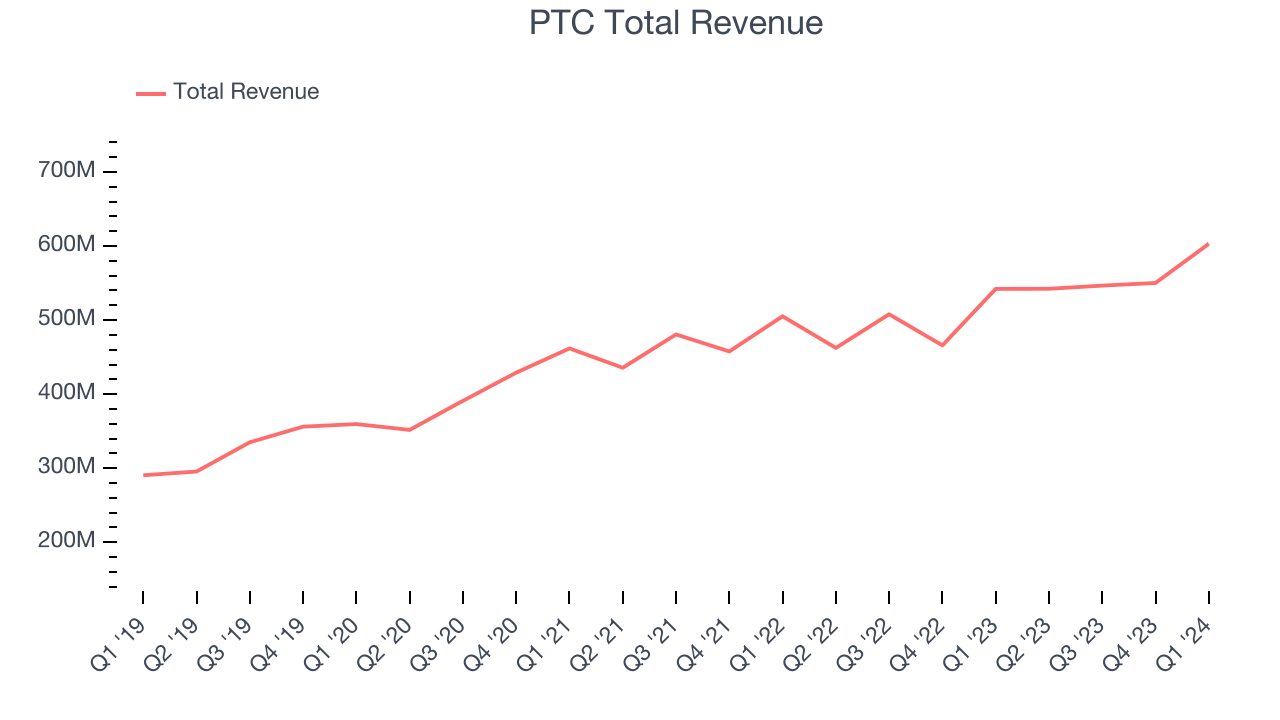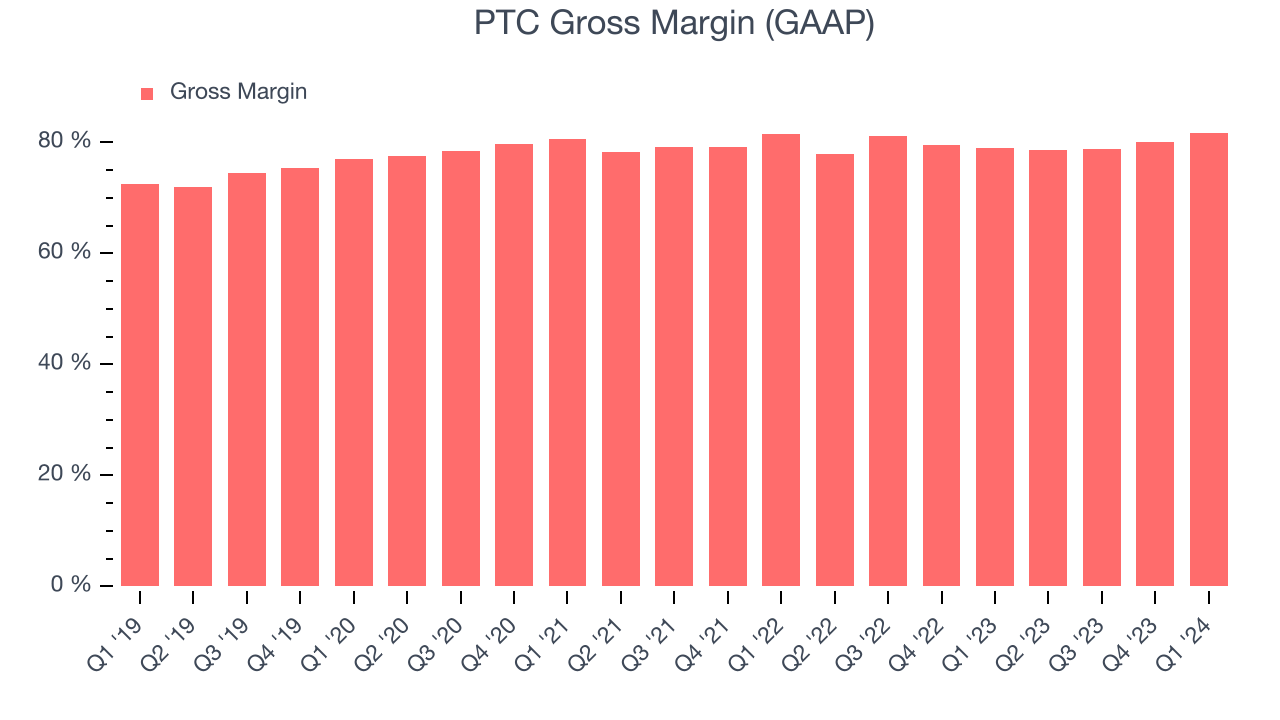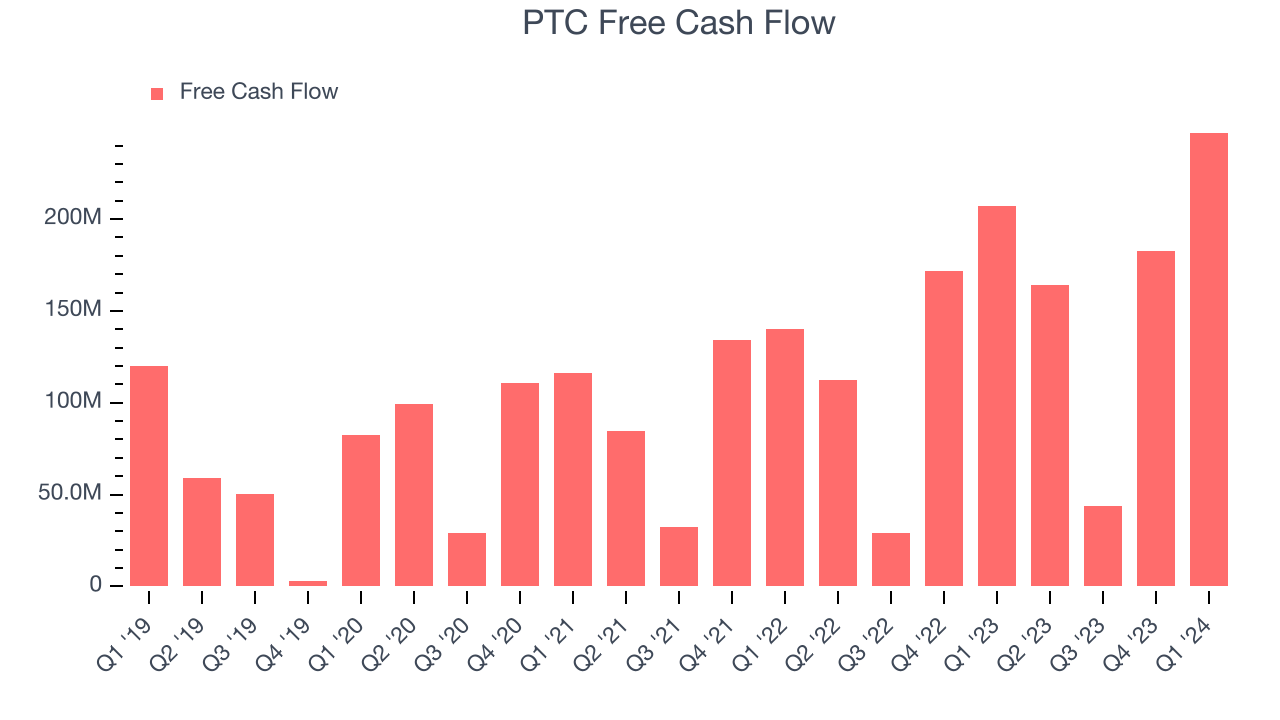PTC (NASDAQ:PTC) Beats Q1 Sales Targets But Full-Year Guidance Underwhelms
Adam Hejl 2024/05/01 4:01 pm EDT
Engineering and design software provider PTC (NASDAQ:PTC) beat analysts' expectations in Q1 CY2024, with revenue up 11.2% year on year to $603.1 million. On the other hand, next quarter's revenue guidance of $532.5 million was less impressive, coming in 9.2% below analysts' estimates. It made a GAAP profit of $0.95 per share, improving from its profit of $0.53 per share in the same quarter last year.
PTC (PTC) Q1 CY2024 Highlights:
- Revenue: $603.1 million vs analyst estimates of $577 million (4.5% beat)
- EPS: $0.95 vs analyst estimates of $0.74 (28.5% beat)
- Revenue Guidance for Q2 CY2024 is $532.5 million at the midpoint, below analyst estimates of $586.2 million
- The company reconfirmed its revenue guidance for the full year of $2.31 billion at the midpoint
- Gross Margin (GAAP): 81.8%, up from 79.1% in the same quarter last year
- Free Cash Flow of $247.1 million, up 35.2% from the previous quarter
- Annual Recurring Revenue: $2.09 billion at quarter end, up 10.9% year on year
- Market Capitalization: $21.21 billion
Used to design the Airbus A380 and Boeing 787 Dreamliner commercial airplanes, PTC’s (NASDAQ:PTC) software-as-service platform helps engineers and designers create and test products before manufacturing.
The company’s software specializes in computer-aided design (CAD) and product lifecycle management (PLM). CAD provides tools to render designs digitally that results in time saved and better accuracy versus hand drawings. PLM is used to collect data during different phases of design/testing and manage the overall process.
PTC’s customers range from small startups to large multinational corporations across industries such as aerospace, automotive, consumer products, and healthcare. By using the company's products, engineers and designers can reduce the time and cost required to bring new products to market and improve product quality. For example, these engineers can digitally simulate a product’s performance at high temperatures and recognize suboptimal responses that can be corrected with some design changes. This means time and resources are saved by avoiding actually manufacturing the product and finding the defect after that.
PTC generates revenue primarily through the sale of software licenses, mostly based on the number of users in a customer’s organization. There is additional revenue from support, consulting, and training services to ensure customer success.
Design Software
The demand for rich, interactive 2D, 3D, VR and AR experiences is growing, and while the ubiquitous metaverse might still be more of a buzzword than a real thing, what is real is the demand for the tools to create these experiences, whether they are games, 3D tours or interactive movies.
Competitors in engineering and design software include Autodesk (NASDAQ:ADSK), Dassault Systèmes (ENXTPA:DSY), and Cadence Design Systems (NASDAQ:CDNS).Sales Growth
As you can see below, PTC's revenue growth has been unremarkable over the last three years, growing from $461.8 million in Q2 2021 to $603.1 million this quarter.

This quarter, PTC's quarterly revenue was once again up 11.2% year on year. We can see that PTC's revenue increased by $52.86 million quarter on quarter, which is a solid improvement from the $3.59 million increase in Q4 CY2023. Shareholders should applaud the acceleration of growth.
Next quarter, PTC is guiding for a 1.8% year-on-year revenue decline to $532.5 million, a further deceleration from the 17.3% year-on-year decrease it recorded in the same quarter last year. Looking ahead, analysts covering the company were expecting sales to grow 9.7% over the next 12 months before the earnings results announcement.
Profitability
What makes the software as a service business so attractive is that once the software is developed, it typically shouldn't cost much to provide it as an ongoing service to customers. PTC's gross profit margin, an important metric measuring how much money there's left after paying for servers, licenses, technical support, and other necessary running expenses, was 81.8% in Q1.

That means that for every $1 in revenue the company had $0.82 left to spend on developing new products, sales and marketing, and general administrative overhead. Significantly up from the last quarter, PTC's excellent gross margin allows it to fund large investments in product and sales during periods of rapid growth and achieve profitability when reaching maturity.
Cash Is King
If you've followed StockStory for a while, you know that we emphasize free cash flow. Why, you ask? We believe that in the end, cash is king, and you can't use accounting profits to pay the bills. PTC's free cash flow came in at $247.1 million in Q1, up 19.3% year on year.

PTC has generated $638 million in free cash flow over the last 12 months, an eye-popping 28.5% of revenue. This robust FCF margin stems from its asset-lite business model, scale advantages, and strong competitive positioning, giving it the option to return capital to shareholders or reinvest in its business while maintaining a healthy cash balance.
Balance Sheet Risk
As long-term investors, the risk we care most about is the permanent loss of capital. This can happen when a company goes bankrupt or raises money from a disadvantaged position and is separate from short-term stock price volatility, which we are much less bothered by.
PTC is a well-capitalized company with $249 million of cash and $183.8 million of debt, meaning it could pay back all its debt tomorrow and still have $65.18 million of cash on its balance sheet. This net cash position gives PTC the freedom to raise more debt, return capital to shareholders, or invest in growth initiatives.
Key Takeaways from PTC's Q1 Results
We enjoyed seeing PTC exceed analysts' billings expectations this quarter. We were also excited its revenue outperformed Wall Street's estimates. On the other hand, its revenue guidance for next quarter missed analysts' expectations and its full-year revenue guidance missed Wall Street's estimates. Overall, the results could have been better. The stock is flat after reporting and currently trades at $174.75 per share.
Is Now The Time?
When considering an investment in PTC, investors should take into account its valuation and business qualities as well as what's happened in the latest quarter.
Although we have other favorites, we understand the arguments that PTC isn't a bad business. Although its revenue growth has been uninspiring over the last three years with analysts expecting growth to slow from here, its bountiful generation of free cash flow empowers it to invest in growth initiatives.
Given its price-to-sales ratio of 8.6x based on the next 12 months, the market is certainly expecting long-term growth from PTC. There are things to like about PTC, and there's no doubt it's a bit of a market darling, at least for some. However, we think there are better opportunities elsewhere right now.
Wall Street analysts covering the company had a one-year price target of $201 right before these results (compared to the current share price of $174.75).
To get the best start with StockStory, check out our most recent Stock picks, and then sign up for our earnings alerts by adding companies to your watchlist here. We typically have the quarterly earnings results analyzed within seconds of the data being released. Especially for companies reporting pre-market, this often gives investors the chance to react to the results before everyone else has fully absorbed the information.